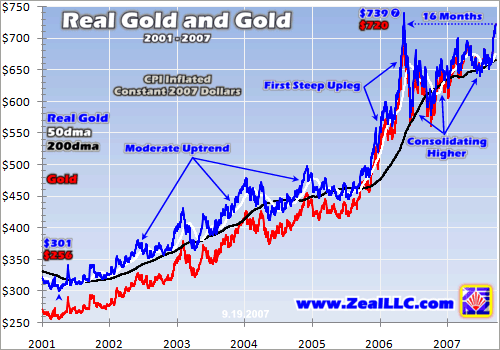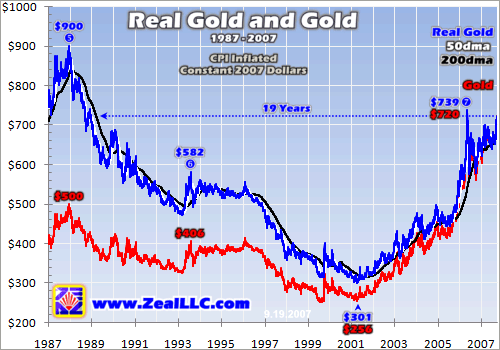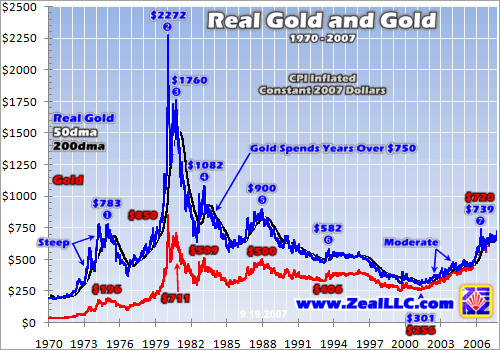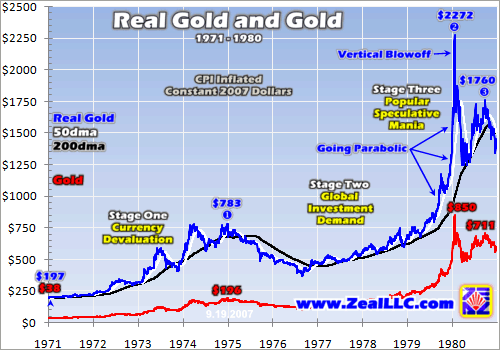|
|
|||||||
|
|
|
|
|
|
|
|
|
|
Real Gold Highs 2 Adam Hamilton September 21, 2007 3550 Words
Holy cow! How about that gold price this week? With the Ancient Metal of Kings powering to awesome new bull-to-date highs, gold traders are rejoicing. The Bernanke Fed’s reckless decision on Tuesday to shove the ailing US dollar off a cliff has really ignited a fire under international gold investment demand.
$725+ gold is indeed remarkable to behold. It is a great blessing for us battle-hardened contrarians who were buying gold back in 2001 in the sub-$300 range when even mentioning “gold” in public triggered endless ridicule. Vindication, especially since it has been accompanied by legendary profits and rapidly multiplying wealth, has never been sweeter.
Forging over $725, gold has truly entered a lofty rarified-air realm where it has seldom tread. In fact, prior to this week, gold only closed above $725 Federal Reserve Notes per troy ounce one other time in all of history! From January 16th to January 22nd in 1980, gold managed to close above $725 for five consecutive trading days. The fourth day of this span, January 21st, witnessed gold’s all-time closing high of $850. Until this week, over 27 years later, gold never again closed over $725.
So with this metal now at its sixth-highest closing level ever in US-dollar terms, the mainstream financial media is weighing in. The same pundits, analysts, networks, and publications that swore sub-$300 gold was a terrible investment six years ago are convinced gold’s latest highs are unsustainably extreme. They argue that it is foolish to buy anything at 27-year highs and even that “a gold bubble” is due to pop.
But just as they were mistaken about gold under $300, odds are they are as equally wrong today. Wall Street has never liked gold because it thrives when general stocks languish in secular bears, competing for investment capital. Governments have never liked gold because it exposes their endless fiat-paper inflation schemes. So it is no surprise that the same establishment that was hyper-bearish on gold every step of the way from April 2001’s $256 to today still loathes this metal.
While gold’s bull still looks young today in fundamental terms due to global demand growth far outpacing global mined-supply growth, now I want to focus on a technical argument. Although there is no doubt that gold now sojourns at lofty levels in nominal terms, due to the Fed’s perpetual inflation there is just no real comparison between January 1980 and September 2007.
Back in early 1980 at the end of the last secular gold bull, the US dollar was worth a lot more. If you were old enough to buy anything back then, you know exactly what I mean. New houses averaged $76k. The median US household income was under $18k. The average new car price was less than $6k. A candy bar cost just a quarter. It was a radically different world in price terms compared to what we face today in autumn 2007.
Prices rise over time simply because the Federal Reserve creates too much money out of thin air. If the money supply rises faster than the actual pool of goods and services on which to spend it, prices rise. Relatively more dollars compete for relatively fewer goods and services, bidding up prices. This is the true definition of inflation, which is exclusively a monetary phenomenon.
Between January 1980 and today, the US MZM money supply ballooned by 9.1x! Of course the US economy grew too, but nowhere close to as fast as the Fed ramped the money supply. So prices had no choice but to climb much higher over the last few decades. Even the US Consumer Price Index has climbed 2.7x higher since gold last traded above $725. So comparing 1980 to 2007 in nominal, or non-inflation-adjusted, terms is irrational and illogical.
Thus the financial media’s hysteria surrounding this week’s 27-year gold highs, although technically true in nominal terms, is incredibly misleading. 27 years ago $725 went a whole heck of a lot farther in terms of purchasing power than it would today. Straight nominal price comparisons across such vast gulfs of time are an apples-to-oranges kind of thing, totally useless. They make as much sense as you trying to live on your 1980 salary in today’s world. Odds are you’d be living in a cardboard box and eating cold ramen!
While nominal comparisons across decades are meaningless, real (inflation-adjusted) ones paint a far more accurate picture. This week’s gold highs need to be considered in real terms, adjusted for the tremendous inflation the Fed has unleashed upon Americans since 1980. When you look at gold in real terms, a radically different picture emerges.
To adjust the daily gold price for inflation in this essay, I used the CPI. Yes, I hate the CPI. Yes, it seriously understates true monetary inflation since the government has huge incentives to lowball it. Higher CPI numbers mean higher government welfare payments and hence less funds for politicians’ pet projects. Higher CPI numbers mean more nervous stock markets and upset voters. Higher CPI numbers mean the US Treasury will have to pay higher interest rates to borrow. And higher CPI numbers shine unwelcome light on the devastating stealth tax of inflation insidiously and relentlessly eroding our savings.
But despite the CPI being a total joke, it remains the most-widely-accepted inflation gauge among mainstream investors. If I used true monetary inflation in these charts, the gold prices shown would be much higher. But by using the CPI these gold prices are very conservative and these arguments will be much more palatable for mainstream minds. Even the hedonized CPI reveals incredible truths about prevailing real gold prices today.
In all these charts this week, the real CPI-adjusted daily gold price is rendered in blue and complimented by key moving averages. Meanwhile the usual nominal gold price is rendered in red in the background for comparison. Of course the farther back in the past we delve, the greater the gulf between real and nominal gold. Also, as usual the data cutoff for this essay was Wednesday’s close. So while I am marveling at $735 gold as I pen this on Thursday, these charts reflect Wednesday data.
We’ll start with just our current gold bull, and telescope out from there to encompass longer periods of history. As of Wednesday, gold’s high in constant 2007 dollars was still below the real May 2006 high of $739. This is very amusing to me, as earlier this week when the media was trumpeting 27-year gold highs in real terms gold was merely at a 16-month high! Talk about misleading.
Since April 2001 this gold bull has powered 182% higher in nominal terms or 146% higher in real terms. Such returns are awesome in an absolute sense, but even more amazing in a relative sense. Gold’s gains since the early 2000s utterly dwarf those of the general US stock markets, which have largely ground sideways. And most of gold’s gains, until late 2005, came in conservative fashion via a moderate uptrend. Such persistently higher prices in the face of such mainstream hostility reflect overwhelmingly bullish underlying supply-and-demand fundamentals for this yellow metal.
My flippant 16-month real-high scenario aside, in reality gold is pushing 19-year real highs as this next chart reveals. Gold last traded for sustained periods above $725 in today’s dollars between 1986 and 1988. Now multi-decade real highs are certainly nothing to scoff at, but they are a far cry from the nearly all-time nominal-high scenario the financial media is promoting to scare investors away from this gold breakout.
Back in late 1987, gold challenged $900 in today’s dollars. Granted, the final months of that particular upleg were driven by the fear generated from the 1987 stock-market crash, but it still shows that gold can go higher than today’s levels without the world ending. Interestingly in all of 1987 before October, gold averaged $805 in today’s dollars. First heading over $725 real in August 1986, the metal remained above these levels until September 1988.
And other than the October 1987 stock-market crash, a weird one-day mid-bull anomaly caused by the first widespread use of computer trading on a panic day, August 1986 to September 1988 was not all that remarkable. Yet real gold traded above today’s levels for this entire span of time because these were the clearing prices where supply and demand met. With gold trading above today’s levels for two solid years so recently, it really makes today’s highs seem a lot less intimidating than the financial media claims.
But real gold gets the most interesting when we look at the really big picture, since 1970. Once properly adjusted for inflation to make a legitimate apples-to-apples comparison, today’s gold levels look positively low compared to the strong gold prices of the early 1980s. This real blue line, as opposed to the red nominal one, is the only rational way to view the gold price over such a long multi-decade span of time.
Note that gold in constant 2007 dollars spent the better part of five years over $750 in the early 1980s! In order to get anywhere close to hitting an all-time real high today, gold would have to rocket to nearly $2300 per ounce! This, more than anything, puts today’s gold levels in proper perspective. Gold may be high in nominal terms today, but it remains quite low relative to where its last secular bull gave up the ghost.
It is also interesting to consider today’s gold levels relative to the major secular gold highs of the past four decades. There have been seven of these highs, all of which are numbered above. For every secular high, the inflation-adjusted gold price is labeled in blue and the nominal one in red. While the gold price is certainly significant today, it is still only higher than one of these six secular real highs so far.
Although this chart is pretty self-explanatory, that gold is not all that high today compared to a secular bull top, there are some interesting observations to consider. For example, note that it was near $750 real in 1979 when gold went parabolic and tripled in about 8 months. It is provocative that we are once again nearing the same real levels at which the last gold superspike started. On the other hand though, gold’s biggest slump of the 1970s also started near $750 real in late 1974. I’ll discuss this further after the next chart.
Before that though, I do realize $2300 gold seems impossibly high today. But we shouldn’t underestimate the power of secular bull markets. Believe me, six years ago this month when gold was trading under $295, $725 seemed impossibly high too. Yet here we are. Long-term bull markets are governed by supply and demand. And since it can take a decade for gold miners to respond to high price signals by bringing new mines online, the gold price can go much higher and stay for much longer than most imagine.
And incredibly, in some ways the all-time $2300 real high shown above is conservative. Of course the CPI is lowballed for political reasons, being reported as far below monetary inflation. As mentioned above, US MZM money has grown by 9.1x since early 1980. In order to witness such a gain over 27 years, an annual compound growth rate of about 8.5% is required. This should be much closer to true inflation than the 3.7% compound CPI growth required over 27 years to see it multiply by 2.7x.
But the gold market is global, and around the world the broad money supplies for first-world nations generally average growth rates around 7% a year. This leads to a conservative estimate of 6.2x more paper money sloshing around the world today than in January 1980. Of course non-first-world countries often have much higher money-supply growth rates, which is one reason this 7% estimate is conservative.
Meanwhile, all the mining in the world only manages to grow the global gold supply by about 1% a year. Provocatively this average has held for centuries due to the extreme difficulty of wresting gold from the bowels of the earth. This slow natural growth in global gold is why it has been the ultimate form of money throughout all of history. Since it cannot grow fast due to natural limitations, excessive inflation is impossible. At 1% growth annually over 27 years, today’s gold supply should be 1.3x as big as 1980’s.
So we have a 27-year estimate in first-world fiat-currency-supply growth of 6.2x compared to 1.3x in global gold-supply growth. Dividing these numbers shows paper-money growth outpacing gold by 4.8x. So based on these assumptions there is 4.8x as much paper money floating around today per ounce of gold as there was in 1980. If you multiply the nominal $850 gold high of January 1980 by 4.8x, it yields $4000 per ounce! Yes, the climax high of today’s secular bull could briefly drive gold to such staggering levels.
But even this may be conservative! In early 1980, Asia was slumbering. Today it is awakening. Several billion people are industrializing and seeking to raise the standards of living for their families. This is fueling global commodities demand the likes of which the world has never seen. As these Asians grow more affluent, they are going to invest in gold. Unlike the West, Asia has a deep cultural affinity for gold (and distrust of paper money) that will never fade. And if a modest fraction of 3b Asians get excited and buy even small amounts of gold each, the potential mania highs in this gold bull are just unimaginable.
So truly the $2300 CPI-adjusted gold price of January 1980 is conservative in many ways. And today’s $725ish gold is so far below the stellar levels that ought to be seen at the next secular top that this bull can only be considered young. So don’t let the financial media convince you that gold over $700 is an extreme event that is unsustainable. Nothing could be farther from the truth based on history.
This final chart shows the famous 1970s secular gold bull in today’s dollars. I believe it is useful as a general pattern, to illustrate the major stages that secular gold bulls go through. While our current bull isn’t going to follow this technical pattern precisely, it should go through the same three major stages.
Early on, gold is primarily bid higher because the predominant currency is being devalued. Only contrarians buy in Stage One as gold remains way out of popular favor. After some years in Stage One, Stage Two arrives. Investors start to notice gold rising and soon buy it for its own intrinsic fundamental merits. The sharp gold upleg in late 2005 likely marked the arrival of Stage Two in our current bull. Thus I suspect we are early on in Stage Two at this point, kind of like 1977ish in this chart.
Eventually so many investors will buy gold that the general public becomes aware of its bull. Since there is no rush like a gold rush, the public will flood in to the market late in the bull’s life. This popular speculative mania is what drives Stage Three. Gold shoots parabolic and ultimately climaxes in a vertical blowoff top. In the 1970s, this mania stage started in mid-to-late 1979 between $750 to $1000 real. Obviously the biggest gains of the entire gold bull by far happen during this brief mania stage.
The key lesson here is that when gold is really ready to hit a secular top in our current bull, everyone will be enthralled by it. Housewives will be trading gold futures. Shoeshine boys will be offering tips on junior gold stocks. CNBC will report on nothing but gold all the time. At every social gathering, talk of gold stocks will be as popular as talk of tech stocks in early 2000. Obviously we are nowhere close to such a popular mania yet. I bet 19 out of 20 people on the street still have no idea that gold is over $700 again.
Although gold ought to once again follow the general three-stage pattern in this chart, I don’t think it is precisely transferable to our current bull. Sometimes people ask me if a slump like 1975 and 1976 is imminent or if we are on the verge of a blisteringly fast tripling in gold like in late 1979. I suspect neither is the case. Today’s gold bull has a life of its own and is not a carbon copy of its 1970s ancestor.
On the slump, our wonderful government had actually banned Americans from owning gold bullion between April 5th, 1933 and December 31st, 1974! But as usual when Washington operates outside the Constitution, most Americans ignored the confiscation order. In 1933 the only gold bullion Washington could seize was the gold kept in bank “safety deposit” boxes. Americans who held their gold bullion outside of banks almost universally ignored Franklin Roosevelt’s appalling theft of private wealth.
So when 1975 rolled around, a lot of this “underground” gold bullion hit the market. Families had held their gold bullion for four decades and suddenly they could legally sell it in early 1975 just after gold had rocketed 419% higher in the early 1970s. There is no similar pent-up selling pressure today. And it wasn’t easy for American investors to buy gold bullion in 1975 either. After 41 years of bullion being considered an Enemy of the State, coin shops were generally not selling low-premium bullion coins. Today buying gold is as easy as buying groceries, and the gold ETFs can even be purchased in a stock trading account.
And central banks in the mid-1970s controlled a vastly larger proportion of above-ground gold than they do today. So their perpetual sales had a far greater effect in 1975 and 1976 than will ever be possible again. The nearly tripling of gold since 2001 despite the best that the central banks could throw at it decisively demonstrates that they are impotent. They are just collectively too small relative to the 80%+ of above-ground gold held by investors.
The Information Age also argues against another mid-bull multi-year gold slump. Thanks to the Internet, the spread of financial-market knowledge is exponentially faster than it was in the 1970s. And if there is one thing that gets investors and speculators excited about deploying capital, it is rising prices. So higher gold prices should get more people interested in gold investment today a lot faster which greatly lessens the probability of a slump. And don’t forget the arrival of hundreds of millions of new gold investors out of Asia today who had no capital in the 1970s!
On the popular mania and vertical blowoff, I think there is a high probability our gold bull will eventually enter Stage Three. But I believe it is some years off yet. Our current gold bull started in April 2001, only about six years ago. The 1970s one ran for nearly a decade before the public grew enamored with gold. Also, broader secular commodities bulls tend to run for 17 years or so in history. While today’s various commodities’ bulls started at different times, at best we are now only one-third of the way into our current 17-year commodities-bull cycle. It is hard for me to imagine gold hitting a secular top many years before commodities in general.
Only time will tell of course, but today’s gold bull still looks relatively young. Real gold prices remain quite low compared to historical highs and gold is still largely ignored by mainstream investors. Most of the general public still doesn’t even seem to know it exists. While gold will correct from time to time, a multi-year slump like the mid-1970s seems unlikely. And while gold will eventually go parabolic, it should be some years later in this gold bull after Stage Two fully runs its course.
At Zeal we have been actively trading this gold bull since early 2001 when gold threatened to slide under $250. Although our physical gold holdings have thrived, our biggest gains by far have been in elite gold stocks. Gold stocks exhibit tremendous profits leverage to gold, soaring far faster and higher than gold could ever go. Fortunes have already been won in elite gold stocks, but if today’s gold bull indeed proves to be young then we haven’t seen anything yet. Subscribe to our acclaimed monthly newsletter today to multiply your capital in elite gold stocks!
The bottom line is gold remains nowhere close to its last secular bull’s real highs of early 1980. Despite what the financial media claims, it is just plain silly to compare nominal prices across decades. Once you adjust the gold price by the most lowballed and conservative estimate of inflation, $725 gold is just one third of the way to the $2300 Stage-Three mania highs witnessed in January 1980.
And gold generally traded above today’s real levels for the vast majority of the entire 1980s. Yet the world as we know it didn’t implode. The fiat US dollar didn’t hyperinflate, the US stock markets remained in a young secular bull, and the bond markets thrived. $725+ gold is really not that big of deal historically and there is no doubt that it is quite sustainable.
Adam Hamilton, CPA September 21, 2007 Subscribe |
|||||||
|
|
|
|
|
|
|
|
|
|
|
|
|
|
|
|||




